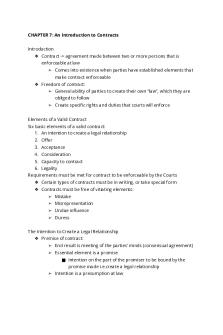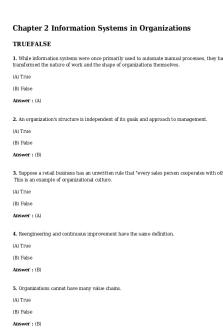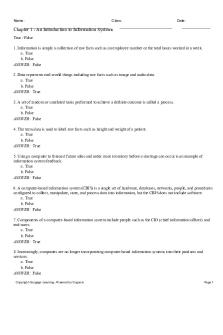Chapter 52 An Introduction to Ecology and Biosphere PDF

| Title | Chapter 52 An Introduction to Ecology and Biosphere |
|---|---|
| Course | AP Biology |
| Institution | High School - USA |
| Pages | 3 |
| File Size | 88.4 KB |
| File Type | |
| Total Downloads | 51 |
| Total Views | 142 |
Summary
This chapter in AP Bio focuses on ecology and biosphere. ...
Description
Chapter 52: An Introduction to Ecology and Biosphere 1) What is ecology? Ecology is the scientific study of the interactions between organism and the environment. 2) Figure 52.2 ★ Organismal ecology- evolutionary adaptations that enable individual organisms to survive in their environment. ★ Population- is a group of individuals of the same species living in an area. ★ Population ecology- analyzes factors that affect population size and how and why it changes through time. ★ Community- is a group of populations of different species in an area. ★ Community ecology- examines how interactions between species, such as predation and competition, affect community structure and organization ★ Ecosystem- is the community of organisms in an area and the physical factors with which tose organisms interact ★ Ecosystem ecology- emphasizes energy flow and chemical cycling between organism and the environment. ★ Landscape ecology- focuses on the factors controlling exchange of energy, materials, and organisms across multiple ecosystems. ★ Biosphere- is the global ecosystem which is the sum of all the planet’s ecosystem and landscapes. ★ Global ecology- examines how the regional exchange of energy and materials influences the functioning and distribution of organism across the biosphere. 52.1 Earth’s climate varies by latitude and season and is changing rapidly 3) What is climate? What four factors are its components Climate is the long-term prevailing weather conditions in a given area. The four factors are temperature, precipitation, sunlight, and wind. 4) What is the difference between macroclimate and microclimate? Macroclimate is patterns on the global, region, and landscape levels, on the other hand, microclimate is very fine, localized patterns, such as those encountered by the community of organisms that live in the microhabitat beneath a fallen log. 5) Figure 52.3 and 52.4. How do these figure influence the temperature and precipitation. The further away from the equator the less sunlight meaning its colder. The earth
rotation cause the different seasons. 6) Why is the Pacific Northwest so rainy? What causes the Mediterranean climate? The Pacific Northwest is so close to the ocean and the aircurrent causes it to rain. The mediterranean climate is due to it location near the equator. 7) Explain “rain shadow” effect. This dry air produces a rain shadow. Land in a rain shadow is typically very dry and receives much less precipitation and cloud cover than land on the windward side of the mountain range. 8) What effect does elevation have on climate? Why do we say that hiking from Gatlinburg,Tennessee, at 393 meters of elevation in the Smoky Mountains region, to the top of Mount LeConte, at 2010 meter, is like traveling to Canada. As you increase your elevation the harder it is to breath. The higher the elevation the less pressure. 9) Every environment on Earth is characterized by abiotic nonliving factors and biotic or living factors 10) Give two examples of how global change can alter the current range of species. Climate change affects migration and effects plants due to increase in carbon dioxide 52.2 11) Biome is any of the world’s major ecosystems types, classified according to the predominant vegetation for terrestrial biomes and the physical environment for aquatic biomes. 12) Temperature and Precipitation 13) Y Axis is Annual mean temperature (C) and the annual mean precipitation (cm) is the x axis. Desert, Temperate grassland, Tropical forest, Temperate broadleaf forest, Northern coniferous forest, and Arctic and alpine tundra. 14) Describe each biome Tropical forest- Located near the equator. Precipitation is relatively constant, about 200-400 cm annually. Temperature average is between 25-29. Desert- the precipitation is low and highly variable, temperature is variable seasonal and daily. Max exceeds 50 (C) and min can fall below -30 (C). It located in bands near 30 north and south latitude. Savanna- little more rain than in desert, higher temperature; small number of flora and fauna Chaparral- diverse temperature, rainfall and flora and fauna
Temperate grassland- moderate rainfall, high temperature has diverse flora and fauna Northern coniferous forest/taiga- high rainfall, low temperature. Diverse flora and fauna Temperate broadleaf forest- very high rainfall, moderate temperature, diverse flora and fauna Tundra- low temperature, moderate rainfall, near the artic zone, small number of flora and fauna...
Similar Free PDFs

Introduction to Ecology
- 7 Pages

Chapter 6 Ecosystem and Biosphere
- 15 Pages

An introduction to Psychology
- 4 Pages

An introduction to sociolinguistics
- 451 Pages
Popular Institutions
- Tinajero National High School - Annex
- Politeknik Caltex Riau
- Yokohama City University
- SGT University
- University of Al-Qadisiyah
- Divine Word College of Vigan
- Techniek College Rotterdam
- Universidade de Santiago
- Universiti Teknologi MARA Cawangan Johor Kampus Pasir Gudang
- Poltekkes Kemenkes Yogyakarta
- Baguio City National High School
- Colegio san marcos
- preparatoria uno
- Centro de Bachillerato Tecnológico Industrial y de Servicios No. 107
- Dalian Maritime University
- Quang Trung Secondary School
- Colegio Tecnológico en Informática
- Corporación Regional de Educación Superior
- Grupo CEDVA
- Dar Al Uloom University
- Centro de Estudios Preuniversitarios de la Universidad Nacional de Ingeniería
- 上智大学
- Aakash International School, Nuna Majara
- San Felipe Neri Catholic School
- Kang Chiao International School - New Taipei City
- Misamis Occidental National High School
- Institución Educativa Escuela Normal Juan Ladrilleros
- Kolehiyo ng Pantukan
- Batanes State College
- Instituto Continental
- Sekolah Menengah Kejuruan Kesehatan Kaltara (Tarakan)
- Colegio de La Inmaculada Concepcion - Cebu











